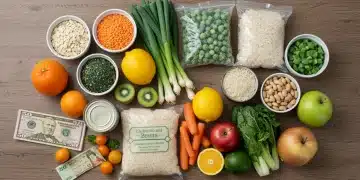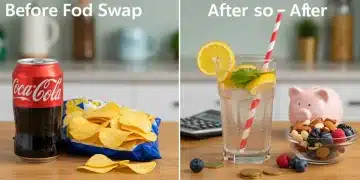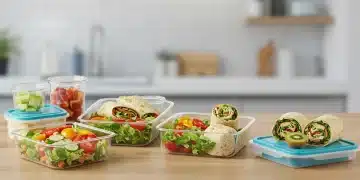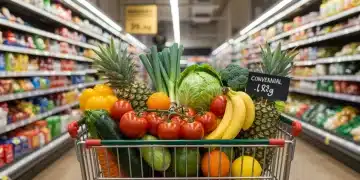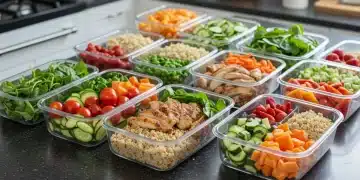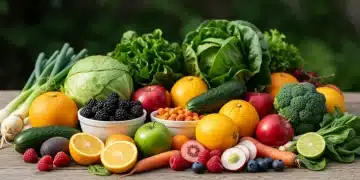Tackling Food Waste: Save 15% on Groceries Annually
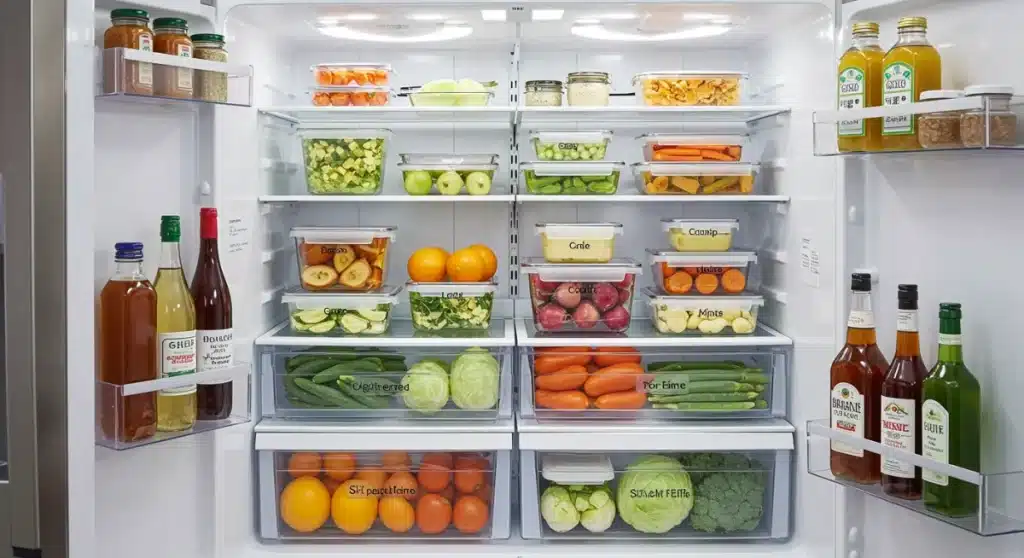
Implementing effective strategies for tackling food waste at home can lead to substantial financial benefits, potentially saving households up to 15% on their annual grocery spending while promoting environmental responsibility.
Are you tired of throwing away perfectly good food and watching your grocery budget disappear? Learning about tackling food waste at home is not just an environmental imperative; it’s a smart financial move that can significantly reduce your annual grocery expenses. By adopting a few practical solutions, you can minimize waste, maximize your food’s potential, and keep more money in your pocket.
Understanding the True Cost of Food Waste
Food waste is a pervasive issue with far-reaching implications, extending beyond just the environmental impact. For many households, it represents a silent drain on finances, often overlooked until a conscious effort is made to track it. The true cost of food waste encompasses not only the discarded food items themselves but also the resources, time, and money invested in their production, transportation, and purchase.
When food is thrown away, it’s not just the monetary value of that item that is lost. Consider the water, energy, and labor that went into growing, harvesting, processing, and shipping it. All these resources are squandered, contributing to a larger ecological footprint. Moreover, food decomposing in landfills releases methane, a potent greenhouse gas, exacerbating climate change.
The Financial Impact on Households
For the average American family, food waste can account for a significant portion of their grocery budget. Studies suggest that households waste about 30-40% of the food they buy. This translates to hundreds, if not thousands, of dollars annually literally going into the trash. Imagine what an extra 15% savings on your grocery bill could mean for your household budget, whether it’s for savings, investments, or other necessities.
- Hidden Costs: Beyond the initial purchase price, consider the cost of fuel for grocery trips, electricity for refrigeration, and even the time spent shopping for items that ultimately go uneaten.
- Opportunity Cost: The money spent on wasted food could have been used for other household needs, entertainment, or savings goals.
- Environmental Burden: Food waste contributes to greenhouse gas emissions and strains natural resources, costing society as a whole.
By understanding these multifaceted costs, we can better appreciate the urgency and value of implementing effective strategies to reduce food waste. It’s a step towards both personal financial health and global environmental sustainability.
Solution 1: Master the Art of Meal Planning and Smart Shopping
One of the most effective ways to combat food waste begins before you even step into the grocery store. Strategic meal planning and smart shopping habits are foundational to ensuring that every item you purchase serves a purpose and is consumed before it spoils. This approach minimizes impulse buys and ensures you have the right ingredients for your planned meals, reducing the likelihood of food sitting unused in your pantry or refrigerator.
Start by assessing your current inventory. Before making a grocery list, take stock of what you already have. This includes checking your refrigerator, freezer, and pantry. You might be surprised by how many ingredients you already possess that can be incorporated into upcoming meals. This step not only prevents duplicate purchases but also encourages creative cooking with existing items.
Creating a Purposeful Grocery List
Once you know what you have, plan your meals for the week. Consider your family’s schedule, dietary preferences, and any upcoming events that might affect your eating habits. Focus on recipes that can utilize similar ingredients or those that allow for batch cooking. For instance, if a recipe calls for half a head of cabbage, plan another meal that uses the remaining half. This foresight is key to avoiding leftover ingredients that might languish and eventually be thrown out.
- Weekly Meal Schedule: Dedicate time each week to map out breakfast, lunch, and dinner. This helps visualize ingredient needs.
- Ingredient Overlap: Look for recipes that share common ingredients to ensure everything purchased is fully utilized.
- Portion Control: Plan appropriate portion sizes to avoid excessive leftovers that might not get eaten.
With your meal plan in hand, create a precise grocery list. Stick to this list diligently while shopping. Avoid wandering through aisles that might tempt you with unnecessary purchases. Shopping on a full stomach can also help curb impulse buys. Remember, every item you bring home without a plan is a potential candidate for the waste bin.
Solution 2: Optimize Food Storage for Longevity
Proper food storage is a critical, yet often overlooked, aspect of reducing food waste. The way you store your groceries can dramatically extend their shelf life, preventing premature spoilage and ensuring they remain fresh and appealing for longer. Different foods have different storage requirements, and understanding these nuances is essential for effective preservation.
Begin by understanding the optimal conditions for various types of produce. For example, many fruits and vegetables, such as apples and potatoes, release ethylene gas, which can accelerate the ripening and spoilage of other produce. Storing these separately can make a significant difference. Leafy greens, on the other hand, benefit from being washed, dried, and stored in airtight containers lined with a paper towel to absorb excess moisture.

Fridge, Freezer, and Pantry Organization
Your refrigerator, freezer, and pantry are your primary tools for food preservation. Organizing them effectively can help you keep track of what you have and ensure older items are used first. Implement a ‘first in, first out’ (FIFO) system, placing newly purchased items behind older ones so that older food is consumed before it expires.
- Refrigerator Zones: Utilize different zones in your fridge. The crisper drawers are ideal for fruits and vegetables, while shelves have varying temperatures for dairy, meat, and leftovers.
- Freezing Power: Learn what foods can be frozen. Bread, meat, fruits, and many cooked dishes can be frozen for extended periods, saving them from spoilage. Label everything with the date of freezing.
- Pantry Essentials: Store dry goods in airtight containers to protect them from pests and moisture. Keep an eye on expiration dates and rotate items regularly.
Investing in good quality food storage containers can also make a big difference. Airtight containers prevent air exposure, which is a major cause of spoilage. Vacuum sealers can further extend the life of many foods. By paying attention to these storage details, you can significantly reduce the amount of food that ends up in the trash.
Solution 3: Embrace Creative Cooking and Repurposing Leftovers
Even with the best meal planning and storage, you might occasionally find yourself with ingredients nearing their prime or a small amount of leftovers. This is where creative cooking and repurposing come into play, transforming what might otherwise be waste into delicious new meals. This approach not only saves food but also encourages culinary experimentation and reduces reliance on new ingredients.
Think of ingredients that are softening or browning as opportunities rather than problems. Overripe bananas are perfect for banana bread or smoothies. Wilting vegetables can be revitalized in soups, stir-fries, or roasted dishes. Stale bread can become croutons, breadcrumbs, or a base for a panzanella salad. The key is to see the potential in every item and avoid the knee-jerk reaction to discard it.
Transforming Leftovers into New Dishes
Leftovers are a common source of food waste, often because they’re not appealing enough for a second meal or are simply forgotten. Instead of reheating the exact same dish, consider how you can transform it. Cooked chicken can become a filling for tacos, a topping for a salad, or an ingredient in a casserole. Leftover rice can be turned into fried rice or rice balls.
- Soup/Stock Base: Vegetable scraps (onion skins, carrot tops, herb stems) and even meat bones can be simmered to create flavorful homemade stocks or broths.
- Frittatas & Omelets: Small amounts of cooked vegetables, meats, or cheeses make excellent additions to egg dishes, perfect for breakfast, lunch, or a light dinner.
- Smoothies & Purees: Slightly bruised fruits or vegetables can be blended into refreshing smoothies, healthy purees, or sauces.
The art of repurposing requires a bit of imagination and a willingness to step outside traditional recipes. Keep a running mental list of versatile ingredients and potential transformations. This mindset shift can turn food waste prevention into an enjoyable and creative part of your cooking routine, leading to less waste and more varied meals.
Solution 4: Practice Portion Control and Understand Expiration Dates
Two fundamental aspects often contributing to food waste are incorrect portioning during cooking and a misunderstanding of food labeling, particularly expiration dates. Addressing these areas can significantly impact the amount of food you discard, leading to both financial savings and a more efficient kitchen.
Cooking too much food is a common habit, often leading to excessive leftovers that spoil before they can be consumed. Take time to understand appropriate portion sizes for your household. Use measuring cups and scales if necessary, especially for ingredients like pasta, rice, or grains that expand during cooking. It’s often better to cook slightly less and have the option to make more if needed, rather than consistently over-preparing.
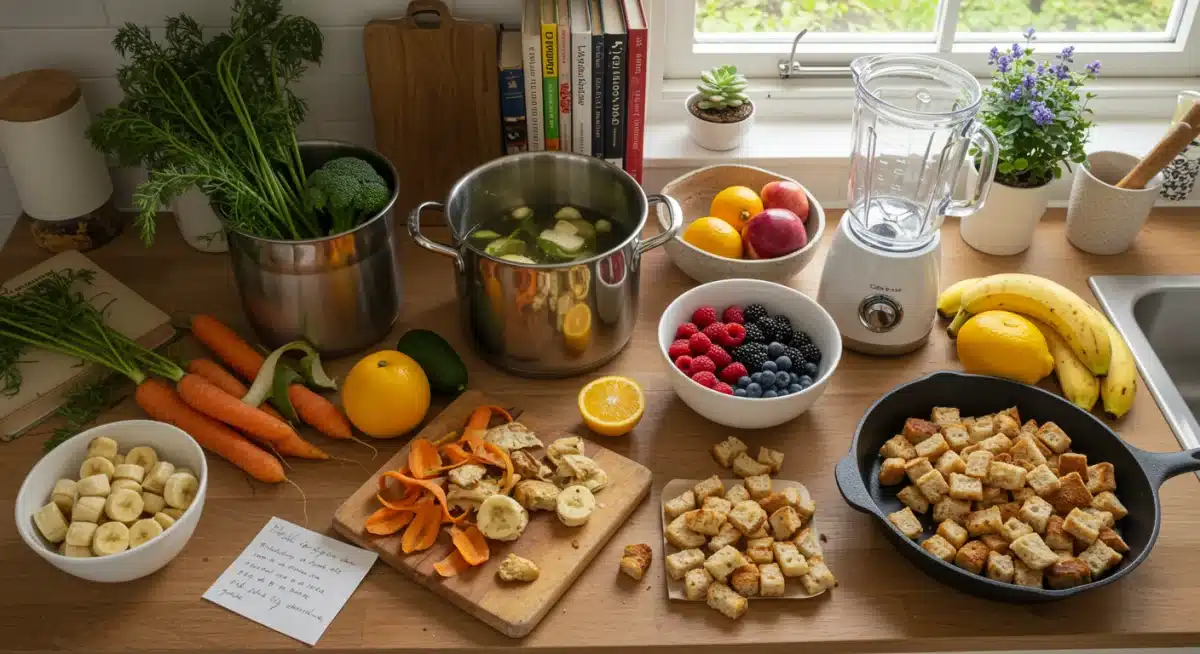
Decoding Food Labels
Food labels can be confusing, and many consumers mistakenly discard food based on ‘best by’ or ‘sell by’ dates when the food is still perfectly safe to eat. It’s crucial to differentiate between these labels:
- ‘Sell by’ date: This date is for retailers, indicating when the product should be sold by to ensure maximum freshness. The food is typically good for several days after this date if stored properly.
- ‘Best by’ or ‘Best if Used By’ date: This refers to the quality of the product, not its safety. It indicates when the food will be at its peak flavor and texture. Many foods are safe to consume well past this date.
- ‘Use by’ date: This is the only date that truly indicates food safety. After this date, the food may not be safe to eat, even if it looks and smells fine.
By understanding these distinctions, you can make informed decisions about when to discard food. Trust your senses: if food looks, smells, and feels fine, it often is. However, always err on the side of caution with perishable items, especially meat and dairy. Educating yourself on these labels can prevent unnecessary waste and save you money.
Solution 5: Composting and Supporting Local Initiatives
Even with the most diligent efforts, some food waste is inevitable—think of fruit peels, vegetable scraps, or coffee grounds. Instead of sending these organic materials to a landfill, where they contribute to methane emissions, composting offers an environmentally friendly alternative that benefits your garden and the planet. Beyond home solutions, supporting local initiatives further amplifies your impact.
Composting is the natural process of recycling organic matter, such as food scraps, into a rich soil amendment called compost. This compost enriches soil, helps retain moisture, and suppresses plant diseases and pests, reducing the need for chemical fertilizers. It’s a simple yet powerful way to divert waste from landfills and create a valuable resource for gardening.
Getting Started with Composting
Starting a compost system at home can be as simple as a designated bin in your yard or a countertop composter for smaller spaces. Most fruit and vegetable scraps, coffee grounds, tea bags, eggshells, and yard waste (like leaves and grass clippings) are suitable for composting. Avoid composting meat, dairy, and oily foods, as they can attract pests and create odors.
- Choose a Method: Decide between traditional outdoor composting, vermicomposting (using worms), or a Bokashi system, depending on your space and needs.
- Balance Greens and Browns: A healthy compost pile needs a balance of ‘greens’ (nitrogen-rich items like food scraps) and ‘browns’ (carbon-rich items like dry leaves or cardboard).
- Aerate and Moisten: Regularly turn your compost pile to aerate it and keep it consistently moist, like a wrung-out sponge, to facilitate decomposition.
Beyond individual efforts, look for local community composting programs or food banks that accept surplus food. Many cities offer curbside composting services or drop-off locations. Supporting local food recovery organizations ensures that edible food reaches those in need, further reducing waste. Engaging with these community efforts strengthens the collective impact against food waste.
Measuring Your Progress and Sustaining Habits
Implementing new habits to reduce food waste is a journey, not a destination. To truly maximize your savings and environmental impact, it’s beneficial to periodically measure your progress and continuously refine your strategies. This reflective process helps identify what’s working well, what needs adjustment, and where further improvements can be made.
Begin by establishing a baseline. For a week or two, consciously observe and even record the amount and type of food you are throwing away. This initial audit can be incredibly eye-opening, revealing patterns of waste you might not have noticed. Are you consistently discarding uneaten leftovers? Are certain types of produce spoiling before you can use them? This data will guide your efforts.
Tracking Your Savings and Impact
Once you’ve implemented the practical solutions discussed, continue tracking your waste and, more importantly, your grocery spending. You might notice a gradual but significant decrease in your weekly or monthly grocery bills. Keep a simple log or use a budgeting app to monitor these changes. Seeing tangible financial benefits can be a powerful motivator to maintain your new habits.
- Waste Audit: Periodically conduct a food waste audit to identify recurring waste patterns and target specific areas for improvement.
- Grocery Bill Comparison: Compare your grocery expenditures before and after implementing waste reduction strategies to visualize your savings.
- Feedback Loop: Use your observations and financial data to refine your meal plans, shopping lists, and storage methods continually.
Sustaining these habits requires ongoing commitment. Share your experiences with family members, involving them in the process of meal planning, cooking, and waste reduction. Make it a family effort, and celebrate small victories. Remember, every little bit of food saved contributes to a healthier planet and a healthier wallet.
| Key Solution | Brief Description |
|---|---|
| Meal Planning | Plan meals weekly and create precise grocery lists to avoid impulse buys and unused ingredients. |
| Optimized Storage | Store foods correctly based on their needs to extend shelf life and prevent premature spoilage. |
| Creative Cooking | Repurpose leftovers and use nearing-expiration ingredients in new, inventive dishes. |
| Composting | Transform unavoidable organic waste into nutrient-rich soil for gardening, reducing landfill contributions. |
Frequently asked questions about food waste
The primary causes of food waste at home often include over-purchasing, poor meal planning, misunderstanding expiration dates, and improper food storage. Consumers frequently buy more than they need or can consume before spoilage, leading to significant amounts of edible food being discarded.
By actively reducing food waste, an average household can save between 10% to 15% on their annual grocery bill. For a family spending $600 a month on groceries, this could translate to savings of $720 to $1,080 per year, which is a substantial amount over time.
No, they are different. ‘Best by’ indicates peak quality, not safety, meaning food may still be good after this date. ‘Use by’ is a safety date; food should not be consumed after this date, especially perishables, to avoid health risks.
Wilting vegetables can be easily repurposed into soups, stews, stir-fries, or roasted dishes. They can also be blended into smoothies or sauces. Even scraps like carrot peels and onion skins are excellent for making homemade vegetable broth, maximizing their utility.
Composting diverts organic waste from landfills, where it would otherwise decompose anaerobically and produce methane, a potent greenhouse gas. Instead, composting transforms food scraps into nutrient-rich soil amendment, reducing environmental pollution and enriching gardens.
Conclusion
Tackling food waste at home is a powerful step towards both financial stability and environmental responsibility. By consistently applying strategies such as meticulous meal planning, optimized storage, creative cooking, portion control, understanding food labels, and embracing composting, households can significantly reduce their grocery expenses—potentially saving up to 15% annually—while contributing to a more sustainable planet. These practical solutions are not just about preventing waste; they are about fostering a mindful approach to food that benefits individuals, communities, and the environment as a whole.
